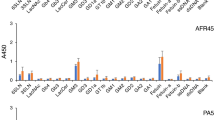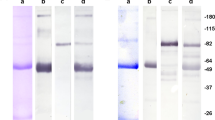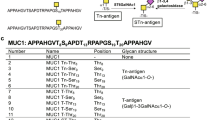Abstract
The Ca antigen, which can be detected in a wide range of malignant human tumours by means of the Cal antibody, is a glycoprotein of the mucin type. At least 95% of the carbohydrate is 0-glycosidically linked to the polypeptide which contains high proportions of glycine, serine and glutamic acid. The carbohydrate has a very simple structure: it is composed almost entirely of tetra- tri- and disaccharides having the general formula (NeuNac)n leads to [Gal leads to GalNac] alpha leads to, where n = 0, 1 or 2. In many malignant cell lines, the antigen is produced constitutively in vitro; but in one that has been examined, its synthesis can be induced by high concentrations of lactate. Evidence is presented for the view that a primary function of this glycoprotein is to shield the cells that produce it from hydrogen ion concentrations outside of the physiological range. The presence of the Ca antigen in malignant tumours may thus be a reflection of metabolic conditions that are known to be characteristics of such tumours.
This is a preview of subscription content, access via your institution
Access options
Subscribe to this journal
Receive 24 print issues and online access
$259.00 per year
only $10.79 per issue
Buy this article
- Purchase on Springer Link
- Instant access to full article PDF
Prices may be subject to local taxes which are calculated during checkout
Similar content being viewed by others
Additional information
This paper is based on a lecture delivered at a Cancer Research Campaign Symposium held in London on 15th March 1983.
Rights and permissions
About this article
Cite this article
Bramwell, M., Bhavanandan, V., Wiseman, G. et al. Structure and function of the Ca antigen. Br J Cancer 48, 177–183 (1983). https://doi.org/10.1038/bjc.1983.173
Issue Date:
DOI: https://doi.org/10.1038/bjc.1983.173
This article is cited by
-
Mucins in cancer: protection and control of the cell surface
Nature Reviews Cancer (2004)
-
Immunochemotherapy of human colon carcinoma xenografts in nude mice using combinations of idarubicin‐monoclonal antibody conjugates
Immunology & Cell Biology (1993)



